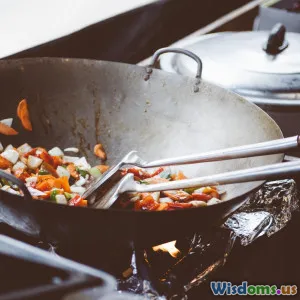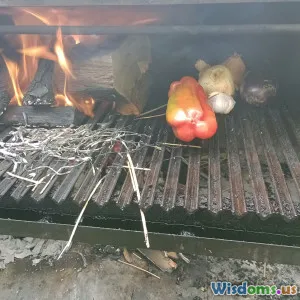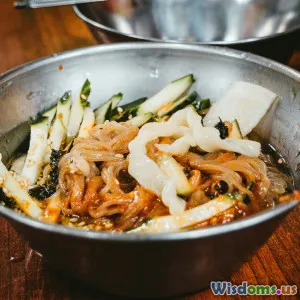
How to Master Batch Cooking for Healthy Lunches
7 min read Unlock the secrets of batch cooking to simplify your lunch routine with nutritious, time-saving meal prep strategies. (0 Reviews)
How to Master Batch Cooking for Healthy Lunches
Eating healthy lunches every day can feel like a daunting task, especially with a busy schedule. Yet, those who succeed in maintaining a nutritious diet often swear by one powerful strategy: batch cooking. Imagine opening your fridge on a hectic weekday and having a delicious, balanced lunch ready to go—no last-minute scrambling, no unhealthy takeout temptations. This isn’t a dream; it’s a skill you can master.
In this in-depth guide, we’ll explore the art and science of batch cooking, a method that allows you to prepare large quantities of food in one go, making your life easier and boosting your health. This approach aligns perfectly with modern demands for efficiency and wellness.
Why Batch Cooking Matters for Healthy Living
The benefits of batch cooking extend beyond saving time:
- Consistency in Nutrition: Preparing meals ahead ensures you control the ingredients, sticking to balanced macros and avoiding processed foods.
- Cost-Effectiveness: Buying ingredients in bulk and reducing food waste lowers grocery bills significantly.
- Stress Reduction: Rush-hour cooking is stressful. With prepared meals, you breeze through your day, confident in your nutrition.
According to a 2020 study by the British Nutrition Foundation, meal prepping participants reported a 50% reduction in unhealthy food consumption and increased daily intake of fruits and vegetables over 12 weeks.
Getting Started: Planning Your Batch Cooking
Assess Your Weekly Schedule
Begin by mapping out your week. How many lunches do you need? What’s your typical lunch routine: reheated meals, salads, wraps? Assessing your schedule helps you determine meal portions and prep frequency.
Select Balanced Recipes
Aim for meals incorporating lean proteins, complex carbohydrates, healthy fats, and vibrant vegetables. For example, quinoa salad with grilled chicken, roasted sweet potatoes, avocado, and mixed greens provides fiber, protein, and essential vitamins.
Invest in Quality Storage Containers
Leak-proof, microwave-safe containers with compartments make storing and reheating seamless. Glass containers help avoid chemical leaching and keep food fresh longer.
Create a Detailed Shopping List
Based on your recipes, list exact quantities. This avoids overbuying or missing ingredients, crucial for an efficient cooking session.
Mastering Core Batch Cooking Techniques
Cook in Large Batches, but Modularize
Instead of preparing fully assembled dishes, cook components separately. For example, roast proteins, steam vegetables, and cook grains independently. This modularity allows mixing and matching, providing variety throughout the week.
Use Versatile Methods
- Roasting: Perfect for vegetables and proteins; caramelizes flavors and requires little attention.
- Slow Cooking: Great for hearty stews, beans, and tougher cuts, enhancing nutrition by slow simmering.
- One-Pot Cooking: When time is extremely limited, meals like chili or curries can thrive in a single pot.
Efficient Kitchen Workflow
Organize your batch cooking by starting with items that take longest to prepare, like grains or slow cooker meals, and multitask by prepping vegetables or sauces simultaneously.
Storage and Reheating: Maximizing Freshness and Flavor
Cooling and Storing Safely
Cool cooked food quickly to avoid bacteria growth. Divide into individual meal portions and store in the fridge for up to 4 days or freeze for up to 3 months.
Labeling
Use labels with cooking and freezing dates. An organized freezer reduces food wastage and keeps meals safe.
Reheating Tips
Reheat meals thoroughly to at least 165°F (74°C) to ensure safety. Add a splash of water or olive oil when reheating proteins or grains to maintain moisture.
Examples of Batch Cooking Menus for Healthy Lunches
Mediterranean Quinoa Bowls
- Components: Quinoa, grilled chicken, chopped cucumber, cherry tomatoes, kalamata olives, feta cheese, and tzatziki.
- Storage: Keep components separate; assemble before eating.
Veggie-Packed Lentil Soup
- Rich in plant-based protein and fiber.
- Freeze in single servings for ultimate convenience.
Stir-Fry Veggies with Tofu and Brown Rice
- Cook and store rice and tofu separately.
- Stir-fry mixed vegetables fresh or use pre-roasted veggies.
Real-World Insights: Hear From Batch Cooking Champions
Sarah, a nutritionist and busy mom, shares: "Batch cooking transformed my weekdays. I spend 2 hours on Sundays, and lunch is ready all week. Plus, my kids eat more veggies when meals are colorful and varied."
Chef David Thompson notes, "Batch cooking encourages creativity within constraints. You learn to balance flavors when cooking components separately, which can elevate simple meals."
Troubleshooting Common Batch Cooking Challenges
- Flavor Fatigue: Vary herbs, spices, and sauces weekly to keep meals exciting.
- Storage Space: Utilize stackable containers; freeze portions if fridge space is limited.
- Time Constraints: Start small, batch cook just 2-3 days, and expand as you get more comfortable.
Final Thoughts: Commitment, Creativity, and Consistency
Mastering batch cooking isn't just about cooking ahead; it’s a lifestyle change that fosters healthier eating habits, financial savings, and mental clarity. With thoughtful planning, strategic cooking methods, and practical storage techniques, you’ll empower yourself to enjoy nutritious lunches effortlessly throughout the week.
Give batch cooking a try—you might soon find it an irreplaceable tool in your culinary repertoire and wellness journey.
Additional Resources
- Link to meal planning apps (e.g., Mealime, Paprika)
- Recommended kitchen gadgets for batch cooking (Instant Pot, food processor)
- Nutrition guides for balanced meals
Embark on your batch cooking adventure and savor the benefits of stress-free, wholesome lunches every day!
Rate the Post
User Reviews
Popular Posts

















